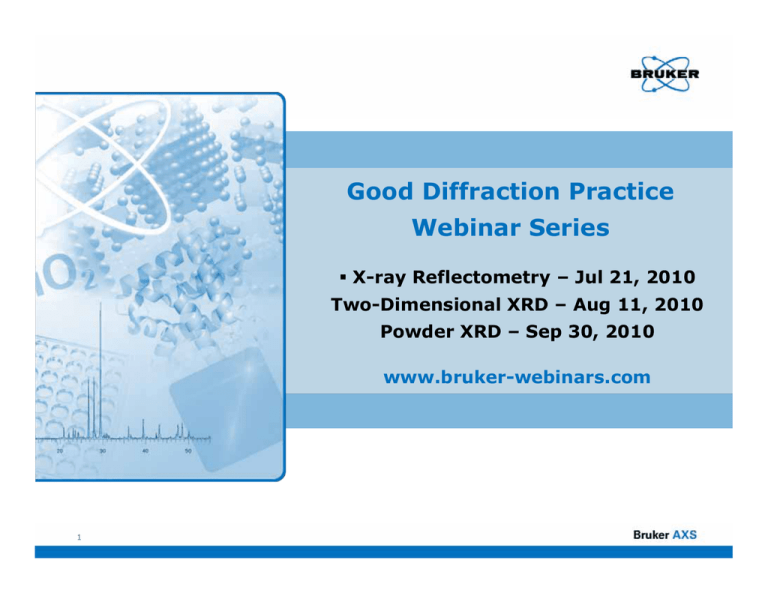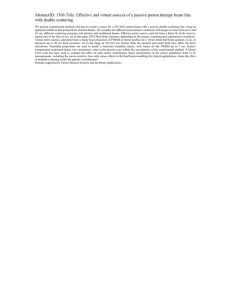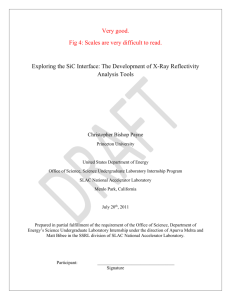X-ray Reflectometry
advertisement

Good Diffraction Practice
Webinar Series
X-ray Reflectometry – Jul 21, 2010
Two-Dimensional XRD – Aug 11, 2010
Powder XRD – Sep 30, 2010
www.bruker-webinars.com
1
Welcome
2
Peter LaPuma
Dr. Martin Zimmermann
Vice President of Sales & Marketing
Bruker AXS Inc.
Madison, Wisconsin, USA
peter.lapuma@bruker-axs.com
+1.608.276.3000
Applications Scientist, XRD
Bruker AXS GmbH
Karlsruhe, Germany
martin.zimmermann@bruker-axs.de
+49.721.595.4655
Overview
Introduction
Appropriate samples for XRR
Adapting the experimental setup
Performing an XRR experiment
Data interpretation
3
What is X-ray Reflectometry (XRR)?
A surface-sensitive x-ray scattering technique
• Non-destructive method
• Wavelength probes on nanometer scale
• Works for crystalline and amorphous materials
4
What is X-ray Reflectometry (XRR)?
A surface-sensitive X-ray scattering technique
• Non-destructive method
• Wavelength probes on nanometer scale
• Works for crystalline and amorphous materials
What does XRR provide?
• Layer thickness 0.1 nm – 1000 nm
• Material density < 1-2%
• Roughness of surfaces and interfaces < 3-5 nm
5
The general scattering geometry
r
kf
r
ki
r r r
q = k f − ki
2θ
Probed quantity
r 2
r
rr r
S (q ) ∝ ∫ ρ (r ) exp( iqr ) dr
V
6
Probed lengthscale
2
d=
λ
2 sin θ
The specular XRR scattering geometry
z
Wavevector transfer has
a non-zero component
perpendicular to the
sample surface
q=(0,0,qz)
x
q z = 2k sin θ
ki
kf
θ
θ
For Cu-Kα (λ=1.54Å)
q z = 2θ / 140 [nm −1 ]
XRR probes the laterally averaged electron density
S (q z ) ∝ ∫ ρ ( z ) exp( iq z z )dz
2
7
2
ρ ( z ) = ρ ( x, y , z )
x, y
The reflectivity from a substrate –
in one minute
ρ(z)
exp(iqz)
0
8
z
The reflectivity from a substrate –
in one minute
ρ(z)
exp(iqz)
T exp(iQz)
R exp(-iqz)
0
9
z
The reflectivity from a substrate –
in one minute
ρ(z)
exp(iqz)
T exp(iQz)
R exp(-iqz)
z
0
Fresnel reflectivity
q −Q
rF (q ) = RF (q ) =
q+Q
2
10
2
with
Q = q 2 − 16π re ρ
Density dependency of the reflectivity
The higher the electron density ρ(z)
of a material the higher the critical
angle
θc ∝ ρ
The higher the electron density, the
more intensity is scattered at higher
angles
⎛θ ⎞
r ≈⎜ c ⎟
⎝ 2θ ⎠
4
This limits the accessible angular
range for light materials like softmatter films
11
Influence of roughness (1)
Waviness
small inclinations of the surface normal
on a large scale of some 100 nm
broadening of the specular
reflected beam
12
waviness
Influence of roughness (1)
Waviness
small inclinations of the surface normal
on a large scale of some 100 nm
broadening of the specular
reflected beam
microscopic
roughness
waviness
Microscopic Roughness
large inclinations of the surface normal on an atomic scale of a few
nanometers
leads to diffuse reflection of the incident beam
the intensity of the specular reflected beam decreases
13
Influence of roughness (2)
Modeling microscopic roughness
w(z )
Interface is represented by an
ensemble of sharp interfaces
⎛ z2 ⎞
exp ⎜⎜ − 2 ⎟⎟
w( z ) =
2
2πσ
⎝ 2σ ⎠
1
rms-roughness σ: = standard
deviation of the Gaussian distribution
14
Influence of roughness (2)
Modelling microscopic roughness
w(z )
Interface is represented by an
ensemble of sharp interfaces
⎛ z2 ⎞
exp ⎜⎜ − 2 ⎟⎟
w( z ) =
2
2πσ
⎝ 2σ ⎠
1
rms-roughness σ: = standard
deviation of the Gaussian distribution
modified reflection coefficients for rough interfaces:
R(qz ) = RF (qz ) exp (− σ 2 q z 2 / 2 )
15
Exponential decay
Influence of roughness (3)
Roughness decreases the
reflected intensity
dramatically
XRR is highly sensitive to
roughness
Roughness causes diffuse
scattering
The interface roughness
should not be larger than
2-3 nm.
16
XRR from Multilayers: Thickness
fringes (1)
The interference of the waves
reflected from the interfaces
causes oscillations of period
Δq z = 2π / d
The minimal observable thickness
is limited by the maximal
measurable range
The maximal observable thickness
is limited by the instrumental
resolution
The sample should have
thicknesses observable with the
instrumental setup.
17
Thickness fringes (2): Amplitude
Amplitude of the thickness fringes increases
with increasing density
contrast
XRR is quite sensitive to
variations of the electron
density
The sample should have
a good contrast in the
electron density.
18
X-ray Reflectometry
Demands on Sample Properties
Golden Rule:
You should be able to see your
reflection on the surface of the
sample!
Flat and lateral homogeneous - not
structured
Sample roughness < 5nm
Good contrast in electron density
for layered samples
Length of at least 2-5 mm in beam
direction
19
Audience poll
Criteria for XRR samples
Flat and lateral homogeneous not structured
Sample roughness < 5nm
Good contrast in electron density
for layered samples
Length of at least 2-5 mm in
beam direction
20
Please use your mouse to answer
the question to the right of your
screen:
What percentage of your
samples match the criteria for
XRR samples?
o
o
o
o
o
o
< 10 %
10 % - 30 %
30 % - 50 %
50 % - 80 %
80 % - 100 %
100 %
Instrumental resolution in XRR
q
kf
ki
θ
The ideal instrument
21
θ
Instrumental resolution in XRR
Δqx
Δqz
Δθf
Δθi
q
kf
ki
θ
θ
The scattering function S is convoluted
with the resolution function R of the
instrument:
I (q) = ∫ S (Q) R(q − Q) dQ
2
22
Instrumental resolution in XRR
Δqx
Rough estimation of the
resolution: FWHM of the
direct beam ΔΨ
Δqz
Δθf
Δθi
q
kf
ki
θ
θ
The scattering function S is convoluted
with the resolution function R of the
instrument:
I (q) = ∫ S (Q) R(q − Q) dQ
2
23
Δθ = Δψ / 2
Δq z = 2k cos(θ ) Δθ
Δq x = q z Δθ
Instrumental resolution in XRR
Δqx
Rough estimation of the
resolution: FWHM of the
direct beam ΔΨ
Δqz
Δθf
Δθi
q
kf
ki
θ
Δq z = 2k cos(θ ) Δθ
Δq x = q z Δθ
θ
The scattering function S is convoluted
with the resolution function R of the
instrument:
I (q) = ∫ S (Q) R(q − Q) dQ
2
24
Δθ = Δψ / 2
Observation of thickness
fringes requires resolution
better than
Δθ << λ / 2d
The experimental setup for XRR
Parallel beam geometry
Setups with different resolutions
The footprint
25
Simplest setup for XRR
Reasonable resolution requires slit of 50-100 µm
Intensity is on the order of 107 cps
Full energy spectrum creates high background
26
Principle of the Göbel Mirror
Mirror converts ≈0.35° into a parallel beam of 1.2 mm (60-mm mirror)
Integrated intensity >109 cps
Mainly Kα-radiation is reflected
27
Handling the high flux: Automated
Absorber
Scintillation counters linear
up to 2 x 105 cps
10,000 times more intensity
from the tube side
4-position wheel with places
for 4 different absorber foils
standard absorption factors:
Rotary
absorber
28
1 - ~10 - ~100 - ~10000
The standard XRR setup for thin films
Slits can be easily exchanged to tune resolution
A reasonable resolution requires a slit size of 0.1 – 0.2 mm
Integrated intensity ≈ 2x108 cps
29
Reflectometry with different slits
with 0.1 mm slit
~ 6.5 h
30
Reflectometry with different slits
with 0.6 mm slit
with 0.1 mm slit
~ 5 min
~ 6.5 h
31
XRR setup for very thin layers
Full beam on primary side
Soller with resolution down to 0.1°
Integrated intensity ≈ 8x108 cps
32
Limits of X-Ray Reflectometry
Thin layers Example: LaZrO on Si
1*10
1*10
Intensity [au]
1*10
1*10
1*10
1*10
1*10
1*10
1*10
0
-1
-2
-3
-4
6.7 nm LaZrO
-5
Si (111)
-6
-7
-8
2
4
6
8
2θ [°]
33
10
12
14
XRR with an analyzer crystal
Analyzer crystal
improves the resolution:
1-bounce Ge(220)
3-bounce Ge(220)
Analyzer crystal separates Kα1, suppresses diffuse scattering and fluorescence
Crystal can accept the full incident beam
Integrated intensity ≈ 3x107 cps (for a 3-bounce analyzer)
34
XRR setup for thick layers
Monochromator crystal:
4-bounce Ge
Analyzer crystal:
1-bounce Ge(220s)
3-bounce Ge(220s)
Monochromator cystals provide highly parallel and monochromatic beam
Crystals can accept the full incident beam
Integrated intensity ≈ 105 - 106 cps
35
Limits of X-ray Reflectometry
Thick layers example: SiO2 on Si
1e4
Int. [au]
1000
1014 nm SiO2:H
Si
100
10
5
0.11
0.2
0.3
0.4
0.5
0.6
2θ [°]
36
0.7
0.8
0.9
1.0
1.1
Resolution of differents setups
For Cu-Kα radiation: λ ≈ 1.54 Å
Values for Δθ were obtained by scanning the direct beam
Obtained from the rough estimation
37
d ≈ λ / 2Δθ
Tube side
Detector side
Δθ [deg]
dmax [nm]
GM + 1.2mm
0.2° soller
0.06°
73
GM + 0.2mm
0.2mm slits
0.029°
150
2xGe(220a)
0.2mm slits
0.026°
170
GM
3xGe(220s)
0.013°
340
2xGe(220a)
3xGe(220s)
0.01°
440
4xGe(220s)
3xGe(220s)
0.006°
735
4xGe(440s)
3xGe(220s)
< 0.006°
> 735
Audience Poll
Please use your mouse to answer the question to the right of
your screen:
What is the typical film thickness of your XRR samples?
o Very Thin layers < 10 nm
o Thin layers 10 nm – 100 nm
o Medium 100 nm – 200 nm
o Thick layers 200 nm – 350 nm
o Very Thick layers > 350 nm
38
Influence of X-ray wavelength on the
reflectivity
290 nm boron on silicon
(2.29Å)
(1.54Å)
Poll Results
Higher wavelength + better resolution of fringes and higher critical angle
- high air-absorption reduces intensity + air scattering
39
Adapting the optics to the sample
brings the best results
40
Easy change of the resolution on the
tube side…
X-ray tube
Rotary
absorber
41
slit-holder
Goebel mirror
…and more resolution…
X-ray tube
Rotary
absorber
42
2-bounce
Ge(220a)
monochromator
slit-holder
Goebel mirror
…and even more resolution
X-ray tube
Rotary
absorber
43
4-bounce
Ge(220s)
monochromator
slit-holder
Goebel mirror
Automated change of the resolution on
the detector side
Motorized slit
Use of multiple beampath
optics allows changing the
resolution within seconds
Motorized switch between
• one high-resolution beam path
• and two high-flux beam paths
PATHFINDER
optics
44
Automated change of the resolution
on the detector side
Soller + slit
Motorized slit
Analyzer
Analyzer crystal with high resolution
Double slit system for intermediate resolution
Soller for high flux / low resolution
45
Documentation of the experimental
setup
A detailed documentation
of the experimental setup
is mandatory for proper
data-analysis
• Resolution function
• Footprint correction
46
Geometrical corrections –
The footprint (1)
d
d : beam width
L : sample length || beam
D : illuminated area
θ
D
L
47
Geometrical corrections –
The footprint (1)
d
d : beam width
L : sample length || beam
D : illuminated area
θ
D
L
Footprint of the beam on surface
D = d / sin θ
Beam matches the sample size at
θ B = arcsin( d / L)
Below θB the intensity is reduced by
B = sin( θ ) / sin( θ B )
48
Geometrical corrections –
The footprint (2)
Beamsize : 200 µm
49
Controlling the footprint – The Knife
Edge Collimator (1)
50
The KEC allows the removal of the footprint effect by making the probed area
smaller than the sample size
For higher angles, the KEC needs to be lifted from the surface to gain flux
The measurement with KEC will be upscaled to the curve without KEC
Controlling the footprint – The Knife
Edge Collimator (2)
Measurement with KEC
must be performed up to
at least 2θB
with KEC
without KEC
8
10
The high-angle measurement without KEC must
have an overlap with the
KEC – measurement to
rescale the data properly
7
Intensity
10
6
10
5
10
4
10
0,0
0,5
1,0
2θ [deg]
51
1,5
2,0
Performing an XRR measurement
Sample alignment procedure
Measurement strategy
• Statistics
• Diffuse scattering
52
Sample alignment in 5 steps…
Ideal sample alignment
Situation after sample mounting
53
Sample alignment (1): Defining the
2θ scale
Detector scan without sample
2θ
I0
2θ aligned to primary beam
2θ=0°
Instrumental resolution
2Δθ
54
Sample alignment (2): First height
alignment
I0 / 2
z
I(z1/2 )=I0/2
55
z1/ 2
Sample alignment (3): Coarse
alignment of the surface normal
I max / 2
ω
ωmax
56
ωmax
Sample alignment (4): Fine height
alignment
z
I(z1/2 )=I0/2
57
I0 / 2
z1/ 2
Sample alignment (5): Alignment of
the reflection condition
2θ = 0.4°
ω
ωmax
Δθ
ω–offset of surface relative to drive:
Δω = 2θ / 2 − ωmax
Waviness /domains on the sample
surface
58
Sample alignment: Remarks
Determination of the footprint angle θB
ω
θB
If the triangle is not symmetric, the sample is not
centered along the beam.
If the rocking-curve in reflection condition is slighty distorted, e.g. peak
shoulders, align the sample at higher angles (reduction of the illuminated
area)
If the rocking-curve in reflection condition is strongly distorted, e.g.
multiple peaks, rotate the sample 90° or translate the sample along the
beam
No improvement: Reduce the beam size/width and/or if available use KEC
59
Keeping the statistics high – Variable
counting time
CPS
1000 count level
Proper analyses require that the statistics is better than the amplitude
of the oscillations I (θ ) ± I (θ )
The decay of the reflected intensity requires longer counting time at
larger angles to keep the statistics good
60
What do we measure?
GaAs
wafer
Data provided by S. Tiemeyer, TU Dortmund
61
Can we analyze
this measurement
properly?
Measuring the diffuse background
Δqx
Δθ
XRR
ki
θ
Imperfections - like
roughness - cause
diffuse scattering
longitudinal
diffuse scan
kf
θ
diffuse
scattering
Diffuse scattering
contributes to the
reflectivity
Theory of XRR does
not account for
diffuse scattering
Perform a longitudinal diffuse scan to estimate the diffuse
scattering in the specular direction
62
Extracting the true specular reflectivity
True specular reflectivity
I TS (2θ ) = I XRR (2θ ) − I diff (2θ )
GaAs
wafer
Diffuse scattering limits the
accessible 2θ range
Measurement of the diffuse
scattering is time-consuming
Choose large step-size and
interpolate
Data provided by S. Tiemeyer, TU Dortmund
63
Analysis of XRR curves
Fitting of XRR curves
Examples
Limitations
64
Account for the instrumental setup
Analytical calculation of the resolution function
Calculation of the footprint-correction
65
Evaluation of Sample
Fitting Procedure
Sample Model parameterized by {p1,…pN}
XRR Simulation
Comparison with Experiment, χ2 cost function
Minimization of χ2 using Genetic Algorithm,
Levenberg-Marquardt, Simplex,
Simulated Annealing, etc. in view of {p1..pN}
66
Tolerance
Amorphous HfO2 film – Ultra thin films
θ [degees]
67
XRR on MEMS – Ru/SiN film
68
GMR Heterostructure – 8 Layers
Sample courtesy of Dr. Schug, IBM Mainz
69
Limits of XRR: Uniqueness of the
solution (1)
Everything
depends
on the sample
model...
Data provided by S. Tiemeyer, TU Dortmund
70
Limits of XRR: Uniqueness of the
solution (2)
7
10
meas
sin-function (2-layers)
6
10
5
Intensity [a.u.]
10
4
10
3
10
2
10
1
10
χ 2 = 0.007
0
10
0
1
2
3
4
2θ [degrees]
71
5
6
Limits of XRR: Uniqueness of the
solution (3)
7
10
meas
error-function (3-layers)
6
10
5
Intensity [a.u.]
10
4
10
3
10
2
10
1
10
χ 2 = 0.007
0
10
0
1
2
3
4
2θ [degrees]
72
5
6
Limits of XRR: What can we really have
access to?
7
10
meas
simulation
6
10
5
Intensity [a.u.]
10
What does the
sample-model
look like???
4
10
3
10
2
10
1
10
χ 2 = 0.006
0
10
0
1
2
3
4
2θ [degrees]
73
5
6
Limits of XRR: What can we really have
access to?
7
10
meas
simulation
6
10
5
Intensity [a.u.]
10
4
10
3
10
2
10
1
10
χ 2 = 0.006
0
10
0
1
2
3
4
2θ [degrees]
74
5
6
Summary
Choose the right optics
Align the sample properly
Remember to account for diffuse scattering
Do not over-interpret your data
Never forget about the limited spatial resolution
75
Summary
Choose the right optics
Align the sample properly
Remember to account for diffuse scattering
Do not over-interpret your data
Never forget about the limited spatial resolution
Thank you for your attention…
76
Any Questions?
Please type any questions you may
have in the Q&A panel and then
click Send.
77
To Learn More About XRD and XRR
Bruker Training Central (BTC) – Online Training Courses
Web-based training courses delivered through your browser
Include slides, audio, video and participant Q&A
Upcoming live:
• Aug 11 – Good Diffraction Practice II: Two-Dimensional XRD (1 hr)
• Sep 30 – Good Diffraction Practice III: Powder XRD (1 hr)
• Oct 5-6 – X-ray Reflectometry (2 hrs)
On-demand:
•
•
•
•
•
78
Fundamentals of Powder XRD
Powder XRD Data Acquisition & Analysis
Basics of Two-Dimensional XRD
Getting Started with LEPTOS
Getting Started with TOPAS
www.brukersupport.com
Thank you for attending!
Please take a moment to complete the brief
survey on your screen.
Your feedback is very important to us.
79
www.bruker-axs.com
80


